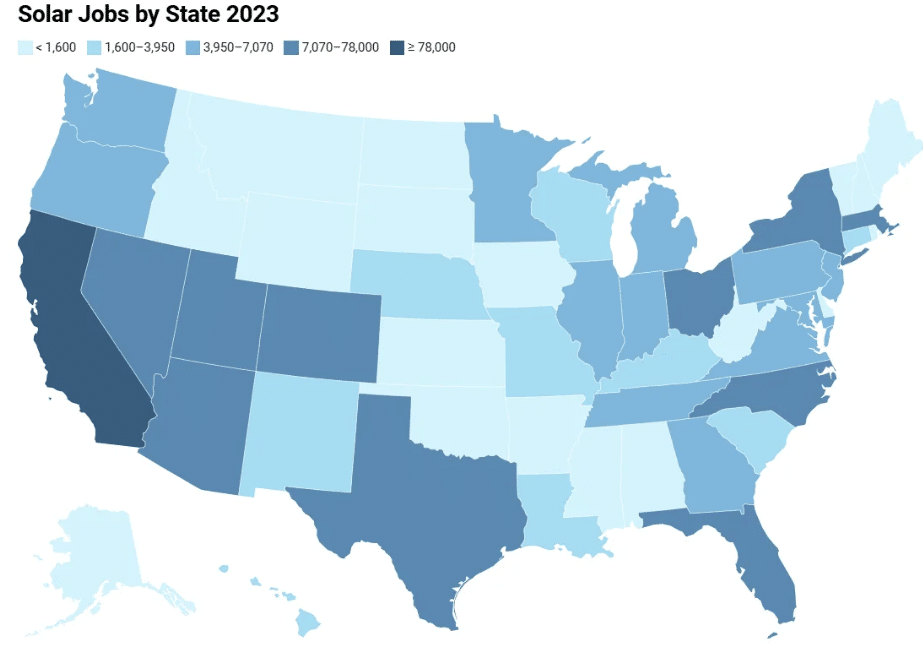Solar Power in the Spotlight: Can It Shine Through a Second Trump Administration?
A new Trump administration could challenge solar power because of its focus on oil and gas. However, the solar power industry contributes to energy independence, a popular narrative among conservative leaders. Despite potential challenges, solar energy may still find support under certain conditions, especially in states with significant solar investments.
1. Red States Benefit Significantly from Solar Jobs
Several Republican-leaning states have experienced robust growth in solar energy jobs, showcasing the growing economic importance of solar power under Trump:
- Texas: Leads in solar energy capacity, with over 10,000 solar jobs by 2023. High electricity demand, lower costs, and strong state incentives have propelled Texas to the top ranking for solar installations.
- Florida: In 2023, Florida had approximately 14,100 solar energy jobs, ranking second nationwide. The state’s solar industry has grown significantly as residential and commercial sectors adopt more solar energy, reducing electricity costs and creating jobs.
The economic contributions of solar power make it politically challenging for the Trump administration to restrict the solar energy industry. Doing so could impact employment and local economies in red states. The growing job opportunities in solar contribute to an “energy independence” narrative, a popular talking point among conservative leaders, which could lead Trump to adopt a moderated approach.

2. Trump’s First-Term Actions on the Solar Industry
Trump’s first term saw policies that both supported and limited solar development:
- Solar Panel Tariffs (2018): Trump imposed a 30% tariff on imported solar panels, intending to boost U.S. solar manufacturing. While this provided a lift for domestic solar panel manufacturers, it raised project costs and resulted in delayed or canceled projects, according to some reports. In total, the tariffs reportedly led to a delay or reduction of over $2.5 billion in solar investments.
- Environmental Rollbacks: Trump’s administration rolled back certain environmental regulations, making it easier for solar projects to secure federal approval. For instance, changes to the National Environmental Policy Act (NEPA) sped up approval processes for large-scale energy projects, including solar, by limiting environmental review requirements.
- Mixed Support for Renewable Energy Funding: While Trump often critiqued renewable subsidies, his administration still extended certain tax credits, like the Investment Tax Credit (ITC) for solar, in limited circumstances. This extension was important for ongoing projects, supporting some growth in the solar sector.
3. Statements and Perspectives from President Trump
President Trump’s views on solar energy have been characterized by skepticism regarding its efficiency and economic viability:
- Efficiency Concerns: He has questioned the reliability of solar power, stating, “It’s an expensive form of energy and, you know, there are problems with it.”
- Subsidy Criticism: Trump has criticized government subsidies for renewable energy, including solar energy, arguing that they distort the market and favor certain industries over others.
Moderately Bearish to Neutral Outlook:
Trump’s second term could lead to a more moderated but challenging environment for solar. While he may not actively dismantle the industry, especially given the jobs it brings to red states, his preference for fossil fuels would likely continue. The solar industry might expect:
- Decreased Federal Funding for Renewables: Likely reductions in federal incentives could slow new solar investments. Projects reliant on federal tax credits might face hurdles, potentially impacting growth in the industry.
- State-Level Momentum and Market Demand: Growth could continue in red states where solar has proven economically beneficial, driven by state incentives and high consumer demand. As solar technology costs continue to decrease, market demand could sustain growth despite federal policy shifts.
- Policy Pressures from Red States: Red states’ economic reliance on solar jobs and energy cost savings may push the Trump administration toward a more balanced stance, reducing outright opposition to solar in certain regions.
In summary, while the Trump administration has preferred hydrocarbon fuels, the economic benefits of solar energy in key states may influence a more balanced approach. Past actions indicate a willingness to support large-scale solar projects under certain conditions, suggesting that future policies could balance support for traditional energy sources with the economic advantages of renewable energy.
Let us know what you think below.Want to learn more?
Alternatively, drop an email erhan at enkiai.com.
Experience In-Depth, Real-Time Analysis
For just $200/year (not $200/hour). Stop wasting time with alternatives:
- Consultancies take weeks and cost thousands.
- ChatGPT and Perplexity lack depth.
- Googling wastes hours with scattered results.
Enki delivers fresh, evidence-based insights covering your market, your customers, and your competitors.
Trusted by Fortune 500 teams. Market-specific intelligence.
Explore Your Market →One-week free trial. Cancel anytime.
Related Articles
If you found this article helpful, you might also enjoy these related articles that dive deeper into similar topics and provide further insights.
- E-Methanol Market Analysis: Growth, Confidence, and Market Reality(2023-2025)
- Battery Storage Market Analysis: Growth, Confidence, and Market Reality(2023-2025)
- Carbon Engineering & DAC Market Trends 2025: Analysis
- Climeworks 2025: DAC Market Analysis & Future Outlook
- Climeworks- From Breakout Growth to Operational Crossroads
Erhan Eren
Ready to uncover market signals like these in your own clean tech niche?
Let Enki Research Assistant do the heavy lifting.
Whether you’re tracking hydrogen, fuel cells, CCUS, or next-gen batteries—Enki delivers tailored insights from global project data, fast.
Email erhan@enkiai.com for your one-week trial.

